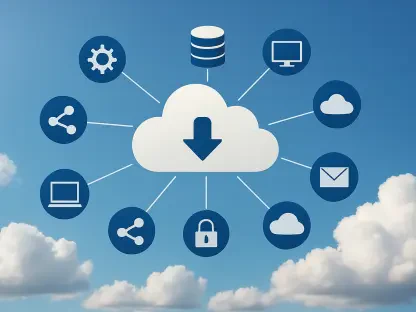The demand for Enterprise Data Loss Prevention (DLP) software is becoming increasingly critical for organizations aiming to safeguard sensitive data from unauthorized access, breaches, and leaks. DLP software solutions employ various security measures such as data encryption, activity monitoring, and compliance enforcement to ensure that data remains confidential and secure at all times. This market has seen substantial growth due to the rising number of cyber threats and the need to comply with stringent regulatory requirements. According to a recent study by HTF Market Intelligence, the global Enterprise DLP Software market is projected to expand from $3 billion in 2023 to an impressive $7.5 billion by 2032, registering a compound annual growth rate (CAGR) of 12.10% from 2024 to 2032. As businesses continue adopting advanced security protocols, the importance of implementing robust DLP solutions is more prominent than ever.
Key Market Players and Competitive Landscape
In the competitive landscape of the Enterprise DLP Software market, several key players have established themselves as industry leaders offering innovative and advanced solutions. Notable companies such as Symantec, McAfee, Trend Micro, Digital Guardian, Forcepoint, and Check Point Software are at the forefront of this growing industry. These companies continuously invest in research and development to enhance their offerings and stay ahead of the competition. They also engage in strategic collaborations, partnerships, and acquisitions to expand their market reach and deliver comprehensive security solutions to their clients.
Emerging players are also making significant strides by introducing new technologies and services to cater to the evolving security needs of businesses. The competitive environment is conducive to advancements in DLP software, leading to the development of more effective and efficient solutions. Companies are incorporating artificial intelligence and machine learning techniques to improve threat detection and response capabilities. This has resulted in the implementation of predictive analytics to anticipate potential security breaches and mitigate risks before substantial damage occurs. The focus on continuous innovation is expected to drive further growth in the market, creating new opportunities for both established players and new entrants.
Market Growth Drivers and Opportunities
The primary drivers behind the significant growth of the Enterprise DLP Software market include the increasing number of data breaches and cyber threats, making robust security measures indispensable. Organizations are facing sophisticated cyberattacks targeting sensitive information, necessitating comprehensive DLP solutions to prevent any unauthorized data access or leakage. Moreover, regulatory compliance requirements have become more stringent, compelling businesses to implement rigorous data protection protocols. The growing concerns regarding data privacy and the need to secure intellectual property are also propelling the adoption of DLP software across various industries.
Another critical factor contributing to the market’s expansion is the rapid proliferation of Internet of Things (IoT) devices and edge computing, which require integrated DLP solutions to ensure data security across diverse platforms. As more devices become interconnected, the amount of data generated and shared increases exponentially, heightening the risk of data breaches. This surge in data necessitates advanced security measures to monitor and control data transfers effectively. Furthermore, the continuous advancements in cloud computing technologies have boosted the demand for DLP solutions, as organizations migrate their data to cloud environments seeking robust protection against potential threats.
Regional Analysis and Market Segments
The global Enterprise DLP Software market demonstrates significant regional disparities in terms of growth rates and market dominance. North America and Europe are identified as the leading regions due to their established technological infrastructure and stringent regulatory frameworks. The presence of key market players in these regions also contributes to their dominance. North America, in particular, is home to some of the world’s largest technology companies, which are pioneers in implementing advanced DLP solutions to protect their vast data assets. Similarly, Europe’s focus on data privacy and protection, driven by regulations such as the General Data Protection Regulation (GDPR), has accelerated the adoption of DLP software.
In contrast, the Asia-Pacific and Latin America regions are witnessing the fastest growth in the Enterprise DLP Software market. The rapid digitization and increasing adoption of new technologies have fueled the demand for robust data protection solutions in these regions. Countries like China, India, and Brazil are emerging as key players in the market, as businesses in these regions become more aware of the critical need for data security. Additionally, the rising number of small and medium-sized enterprises in these regions is expected to create substantial opportunities for market growth. These enterprises are increasingly investing in DLP solutions to protect their sensitive data and maintain compliance with global standards.
Conclusion
The major drivers behind the robust growth of the Enterprise DLP Software market are the rising instances of data breaches and cyber threats, making it critical to implement strong security measures. Companies are combating increasingly sophisticated cyberattacks that target sensitive information, making comprehensive DLP solutions necessary to avoid unauthorized data access or leaks. Additionally, stricter regulatory compliance requirements are pushing businesses to adopt stringent data protection protocols. Concerns about data privacy and the need to safeguard intellectual property are also driving the adoption of DLP software across numerous industries.
A key factor propelling market expansion is the rapid growth of Internet of Things (IoT) devices and edge computing, which demand integrated DLP solutions to secure data across various platforms. The interconnection of more devices leads to a surge in data generation and sharing, increasing the risk of breaches. This uptick in data requires advanced security to effectively oversee data transfers. Moreover, ongoing advancements in cloud computing technologies have amplified the demand for DLP solutions, as companies migrate their data to cloud environments in search of solid protection against potential threats.









